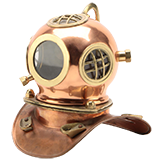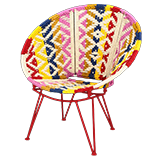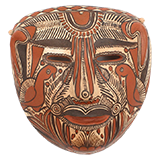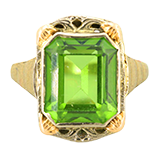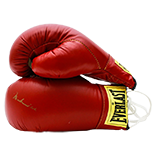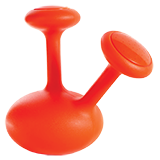Kenneth Noland: Untitled (PK-0144), 1979
Item Details
Kenneth Noland (American, 1929-2010)
Untitled
colored pressed paper pulp on handmade paper
twice signed to verso in artist’s hand, each dated 1979 with several crossed arrows, one uncrossed indicating the vertical, all in graphite
numbered ‘PK-0144’ on verso, in graphite
unmounted and unframed
Provenance
Ex Collection of critic and curator Kenworth Moffett (1934-2016) and Lucy Baker (b. 1955)
Descended in the family to the current owner
An abstract composition consisting of diagonal stripes, composed of colored pressed paper pulp embedded in handmade paper, created in 1979 by celebrated Modern American artist Kenneth Noland (1924-2010). This work features textural handmade paper with irregular deckle edges. A series of diagonal stripes consisting of mostly blue and brown colored pulp span from the upper left down to the lower right area of the composition. Accents of other various colors are embedded within the design. Handwriting to the verso includes the artist’s signature and date of the work.
This work was likely a direct gift from Noland to American curator and art historian Kenworth Moffett (1934-2016), who specialized in Abstract Expressionism and Color Field painters. Moffett included Noland in his curated exhibitions such as Abstract Paintings in the 70’s (1971), and he also wrote a monograph on Noland published in 1977.
This work is an example from Noland’s handmade paper series that spanned from the late 1970s through the early 1980s. Works in the series consisted of simple abstract designs, such as diagonal stripes, horizontal stripes, and concentric circles made with colored pressed paper pulp. Although he began making handmade paper works in the mid-1970s, Noland officially launched his extensive series of handmade papers in 1978 when using the facilities of Tyler Graphics for about five months in New York. He continued creating handmade paper works beyond 1978 outside of Tyler Graphics. As explained by curator Judith Goldman, the artist created works like this ‘by embedding color inside the paper,’ allowing him to ‘define its shape’. An exhibition featuring around twenty of Noland’s handmade paper works was organized at Meredith Long & Company in 2014.
Kenneth Noland was born in Asheville, North Carolina, and studied at Black Mountain College under renowned Modern artists Josef Albers (1888-1976) and Ilya Bolotowsky (1907-1981). Subsequently, in the late 1940s, he traveled to Paris and studied for a year in the Montparnasse studio of Russian-born Cubist sculptor Ossip Zadkine (1890-1967). Celebrated as a major contributor to the development of American Color Field painting, Noland’s signature style consists of simplified abstract geometric shapes, such as stripes, targets, chevron patterns and plaid patterns. Art critic Karen Wilkin (b. 1940) referred to him as ‘one of the greatest colorists of the 20th century’ who, along with Morris Louis (1912-1962) and Helen Frankenthaler (1928-2011), ‘invented a new kind of American abstraction based on the primacy of color’. His work was heavily critiqued and promoted by renowned Modern art critic Clement Greenberg (1909-1994), along with other mid-century Modernists including Anthony Caro (1924-2013), Helen Frankenthaler, and Jackson Pollock (1912-1956) among others.
Noland and Greenberg’s long history likely began as early as 1950, when Greenberg taught and lectured at Black Mountain College. Greenberg included Noland in his 1954 exhibition Emerging Talent held at the Kootz Gallery in New York. Greenberg coined the term ‘Post-Painterly Abstraction’ to describe Noland’s work when he organized an exhibition by the same name in 1964 at the Los Angeles County Museum of Art; the exhibition featured 31 artists including Noland, Friedel Dzubas (1915-1994), Jules Olitski (1922-2007), Morris Louis, and Helen Frankenthaler, among others.
Noland’s relationship with British sculptor Anthony Caro (1924-2013) began in 1959; his abstract work likely impacted Caro’s departure from his earlier figurative style toward work featuring geometric forms. Noland’s relationship with Caro and Modern artist Jules Olitski continued to develop in the 1960s when Noland moved to a farm in South Shaftbury, Vermont nearby Bennington College where both Olitski and Caro taught. The work of the three artists maintained associative ties both during their lifetimes and posthumously. They were the stars of Hartford Art School’s three-person exhibition at the Joseloff Gallery in 1994, and their work continues to be exhibited together in exhibitions today.
Throughout his career, Noland taught at several institutions including the Institute of Contemporary Art in Washington, D.C.; the Catholic University in Washington, D.C.; the Washington Workshop Center for the Arts; and Bard College in upstate New York, to name a few. His work can be found in countless museums such as the Museum of Modern Art, New York; the Art Institute of Chicago; and the Solomon R. Guggenheim Museum, New York, among others.
Condition
- some minor bending and curling along edges of paper.
Dimensions
Item #
17DET014-001




























